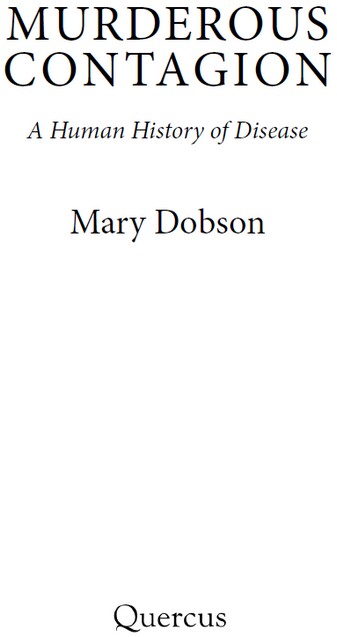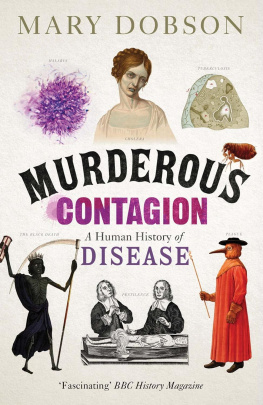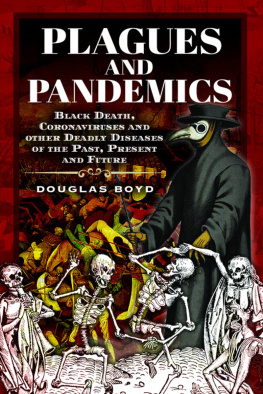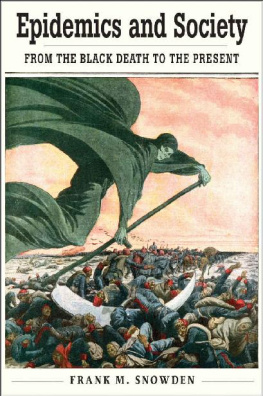Mary Dobson is an historian of medicine and an expert in the history of tropical and infectious diseases. She is the author of numerous publications ranging from academic articles and monographs to popular science and history, including The Story of Medicine (Quercus). She has held a number of prestigious Research Fellowships and was Director of the Wellcome Unit for the History of Medicine and Fellow of Green Templeton College, Oxford.

First published in hardback in 2007 by Quercus Editions Ltd
under the title Disease
This revised and updated paperback edition published in 2015 by
Quercus Editions Ltd
55 Baker Street
Seventh Floor, South Block
London
W1U 8EW
Copyright Mary Dobson 2007, 2015
The moral right of Mary Dobson to be identified as the author of this work has been asserted in accordance with the Copyright, Designs and Patents Act, 1988.
All rights reserved. No part of this publication may be reproduced or transmitted in any form or by any means, electronic or mechanical, including photocopy, recording, or any information storage and retrieval system, without permission in writing from the publisher.
A CIP catalogue record for this book is available from the British Library
PB ISBN 978 1 78206 943 0
Ebook ISBN 978 1 84916 668 3
Contents
Preface
I hope that Lord Grey and you are well; no easy thing seeing that there are about fifteen hundred diseases to which man is subject. Sydney Smith to Lady Grey, February 1836
The diseases described within this book have affected human history in a multitude of ways over the past few millennia. Choosing a selection of diseases out of the fifteen hundred or so suggested by the English clergyman Sydney Smith (17711845) has been both stimulating and challenging. The final decision was based on the idea of including a varied range of some of historys classic plagues and pandemics (amongst which typhus in the early nineteenth century was called a murderous contagion) and to cover those diseases that have had, and continue to have, a major impact in many parts of the world today. I have also chosen a number of less-well publicized diseases (often known as Neglected Tropical Diseases) that still seriously affect some of the poorest countries (where, in the twenty-first century, average life expectancy at birth can be less than fifty or sixty years compared to over seventy or even eighty years in the wealthiest nations), as well as including some of the better-known major non-communicable diseases of the modern era such as heart disease, cancer and dementia, along with a selection of the more unusual and mysterious pestilences which have afflicted humans over the years.
Some of the diseases covered in this book, for example, malaria and schistosomiasis, are ancient diseases possibly first emerging as human diseases some 10,000 years ago when people and domestic animals began to live in close proximity. Infections, like smallpox and measles, which are easily transmitted from person to person, and are often known as crowd diseases, may have accompanied the rise of early urban settlements from around the third millennium BC . The opening up of overland and ocean trade routes, including circumnavigations of the globe from the late fifteenth century onwards, accelerated the spread of many diseases from place to place and continent to continent, and now, with rapid air travel, we are living in a highly interconnected microbial world. Some diseases, notably HIV/AIDS, are relatively new to human society, emerging and spreading rapidly only in the past fifty or so years. Cardiovascular disease and cancer, the two leading causes of deaths worldwide today, together with dementia and type 2 diabetes, are now increasingly prominent in the modern world and are also becoming common in low- and middle-income countries. A few diseases have seemingly come and gone. SARS the first serious and easily transmissible new disease to emerge in the twenty-first century spread around the globe over a short period of time in 2003, was contained, and has, so far, not reappeared, though a recent related viral disease, named MERS-CoV (Middle East respiratory syndrome coronavirus), is of current concern.
Some of the diseases in this book, such as kuru in Papua New Guinea, have had a serious but largely local impact. Several, especially those like malaria, dengue fever and African trypanosomiasis (sleeping sickness), which are transmitted by insect vectors, have had, and continue to have, a devastating effect on tropical and subtropical regions. Others, such as the Black Death (bubonic plague) of the mid-fourteenth century; smallpox, measles, typhus and syphilis from the early sixteenth century; the cholera pandemics beginning in the nineteenth century; the Spanish influenza pandemic of 191819; and the current HIV/AIDS pandemic have been tragedies on a global scale with far-reaching consequences for societies and individuals the world over. Tuberculosis also known historically as the White Plague although thought to have been controlled with antibiotics and vaccines, has resurged in the past few decades, especially as a co-endemic infection with HIV/AIDS in some of the poorest parts of the world. Multi-drug resistant TB is a serious concern and, indeed, antibiotic resistance more generally is now one of the worlds most pressing medical issues. The recent outbreaks of bird flu (H5N1) and swine flu (H1N1) have presented global threats that, fortunately, have not been on the same scale as the 191819 Spanish flu as had been initially feared. Ebola virus a newly emerging disease has attracted worldwide media attention both during its earlier outbreaks in Central Africa in the mid-1970s and, again, in the recent tragic outbreak of this highly contagious and frequently fatal disease in West Africa in 2014 a situation that, as this book goes to press, has escalated to crisis levels. Some two-thirds of human pathogens, which include the Ebola, influenza and HIV/AIDS viruses, are thought to have a zoonotic origin, when infections cross the species barrier and jump or spillover from bats, birds, wild and domestic animals to humans, often adapting in the human host to spread efficiently from person to person.
One disease covered in this book has been effectively eliminated by human intervention. In 1979, the World Health Organization (WHO) announced that smallpox, one of the worst scourges of humanity, had been eradicated from the globe by a vaccine developed nearly 200 years before. This is one of the most outstanding achievements in the history of medicine. Polio is now so close to elimination that we await the final push. More than a decade after world leaders adopted the United Nations Millennium Development Goals (MDGs), 20002015, there have also been some substantial reductions in early childhood mortality with corresponding increases in life expectancy, even in some of the poorest countries. We can only hope that there will be further success stories and that the global burden of disease will be reduced significantly in the coming years.
The diseases chosen have been grouped into four categories and arranged, at least very approximately, according to the first recorded serious impact of each disease on the world, with some of the oldest first and the most recent last. The first three groups comprise infectious diseases: bacterial diseases (from plague to encephalitis lethargica); parasitic diseases (from malaria to onchocerciasis); and viral diseases (from smallpox to SARS and MERS CoV). The fourth group of diseases (scurvy, kuru, CJD, dementia, cancer and heart disease) do not conform to the models of bacterial, parasitic and viral maladies and are loosely labelled lifestyle diseases, since factors such as diet, smoking, physical exercise, occupation and ageing play a key (though not the only) role in their causation. Indeed, for each of the diseases selected whether primarily infectious or non-infectious there is always a complex set of interrelated biological, genetic, environmental and social factors that mean some people succumb, while others survive or remain untouched by the circulating pathogen or potentially fatal disorder.
Next page







